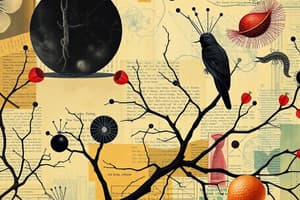Podcast
Questions and Answers
What is the primary function of the mitochondria in a cell?
What is the primary function of the mitochondria in a cell?
- To regulate what enters and leaves the cell
- To synthesize proteins
- To store genetic material
- To generate energy for the cell (correct)
Which branch of biology focuses on the study of relationships between organisms and their environment?
Which branch of biology focuses on the study of relationships between organisms and their environment?
- Botany
- Microbiology
- Ecology (correct)
- Zoology
What is the process by which cells generate energy from glucose?
What is the process by which cells generate energy from glucose?
- Meiosis
- Photosynthesis
- Mitosis
- Cellular respiration (correct)
What is the term for a segment of DNA that codes for a specific trait?
What is the term for a segment of DNA that codes for a specific trait?
What is the process by which individuals with favorable traits are more likely to survive and reproduce?
What is the process by which individuals with favorable traits are more likely to survive and reproduce?
What is the term for the movement of individuals with different alleles into a population?
What is the term for the movement of individuals with different alleles into a population?
What is the term for the study of the structure, growth, evolution, classification, and distribution of plants?
What is the term for the study of the structure, growth, evolution, classification, and distribution of plants?
What is the term for the change in allele frequencies in a population due to chance events?
What is the term for the change in allele frequencies in a population due to chance events?
Describe the structure and function of mitochondria in eukaryotic cells.
Describe the structure and function of mitochondria in eukaryotic cells.
Explain the process of photosynthesis, including its chemical reactions and the role of chloroplasts.
Explain the process of photosynthesis, including its chemical reactions and the role of chloroplasts.
Study Notes
Branches of Biology
- Botany: Study of plants, including their structure, growth, evolution, classification, and distribution.
- Zoology: Study of animals, including their structure, growth, evolution, classification, and distribution.
- Microbiology: Study of microorganisms, including bacteria, viruses, and other microorganisms.
- Ecology: Study of the relationships between organisms and their environment.
Cell Biology
- Cell Structure:
- Plasma membrane: regulates what enters and leaves the cell
- Cytoplasm: gel-like substance inside the cell membrane
- Nucleus: contains genetic material (DNA)
- Mitochondria: generates energy for the cell
- Cellular Processes:
- Photosynthesis: process by which plants convert light energy into chemical energy
- Cellular respiration: process by which cells generate energy from glucose
Genetics
- DNA:
- Double helix structure
- Contains genetic information
- Genes:
- Segments of DNA that code for specific traits
- Can be dominant or recessive
- Inheritance Patterns:
- Autosomal dominant: a single copy of the dominant allele is enough to express the trait
- Autosomal recessive: two copies of the recessive allele are needed to express the trait
Evolution
- Mechanisms of Evolution:
- Natural selection: process by which individuals with favorable traits are more likely to survive and reproduce
- Genetic drift: random change in allele frequencies in a population
- Mutation: change in DNA sequence
- Gene flow: movement of individuals with different alleles into a population
- Evidence for Evolution:
- Fossil record: shows gradual changes in species over time
- Comparative anatomy: similar structures in different species indicate common ancestry
- Molecular biology: similarities in DNA and protein sequences indicate common ancestry
Branches of Biology
- Botany is the study of plants, including their structure, growth, evolution, classification, and distribution.
- Zoology is the study of animals, including their structure, growth, evolution, classification, and distribution.
- Microbiology is the study of microorganisms, including bacteria, viruses, and other microorganisms.
- Ecology is the study of the relationships between organisms and their environment.
Cell Biology
- The plasma membrane regulates what enters and leaves the cell.
- Cytoplasm is a gel-like substance inside the cell membrane.
- The nucleus contains genetic material (DNA).
- Mitochondria generate energy for the cell.
- Photosynthesis is the process by which plants convert light energy into chemical energy.
- Cellular respiration is the process by which cells generate energy from glucose.
Genetics
- DNA has a double helix structure and contains genetic information.
- Genes are segments of DNA that code for specific traits and can be dominant or recessive.
- Autosomal dominant traits require a single copy of the dominant allele to be expressed.
- Autosomal recessive traits require two copies of the recessive allele to be expressed.
Evolution
- Natural selection is the process by which individuals with favorable traits are more likely to survive and reproduce.
- Genetic drift is a random change in allele frequencies in a population.
- Mutation is a change in DNA sequence.
- Gene flow is the movement of individuals with different alleles into a population.
- The fossil record shows gradual changes in species over time, providing evidence for evolution.
- Comparative anatomy reveals similar structures in different species, indicating common ancestry.
- Molecular biology shows similarities in DNA and protein sequences, indicating common ancestry.
Studying That Suits You
Use AI to generate personalized quizzes and flashcards to suit your learning preferences.
Description
Explore the different branches of biology, including botany, zoology, microbiology, and ecology, and delve into the structure of cells. Learn about the plasma membrane, organelles, and more.




